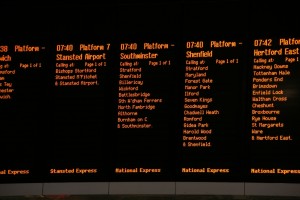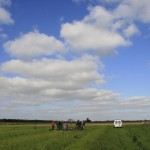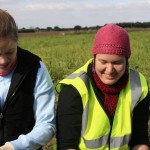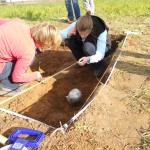7:00am is an exciting time to be at Liverpool Street Station, provided you’re heading out of town. While most of the human stream paddles off in the direction of the underground or the canyons of Bishopsgate and London Wall, you have the prospect of an empty carriage and a relaxed, takeaway breakfast to look forward to.
Three members of the Central Unit found themselves faced with such pleasant circumstances recently, as we left the confines of Russell Square for a one-day dig in East Essex, organized by Laura McLean, the indefatigable Finds Liaison Officer, and her assistant and resident expert in Field Archaeology, Kate Orr. Just a few weeks before, Laura had had reported to her a preponderance of Bronze Age artifacts from a scattered hoard, and crucially, the detectorists who had located the material had come across what they believed was an intact ceramic vessel at the bottom of the ploughsoil. Not wanting to risk damaging the item, and recognising that a more thorough investigation might provide more information about the site, the finders backfilled the hole and resolved to get further assistance. Laura, hoping to get out to the site with the appropriate resources as soon as possible, made the appeal for a bit of manpower from London.
After a short strategic meeting in the capital, plans were finalised for our trip on Tuesday the 12th of October, when Janina Parol and Caroline Barton joined me in the early morning train journey. Unbeknownst to us, we were sharing the same train as Gemma and Justin of the production team contracted for an upcoming BBC archaeology series. Our boss at the British Museum, Michael Lewis, had told Gemma about this small-scale operation, and intrigued at the possibility of filming ‘archaeology in action’, Gemma decided to come along. It was as we disembarked on the single-platform station in rural Essex that we saw Justin and Gemma (who we recognized from a filming of the Frome Hoard) and it suddenly clicked that they could only be headed to the same field that we were. Laura greeted us warmly while at the same time sarcastically thanking her luck in anticipation of having to talk in front of the camera. It was no time at all before her reluctance was a long-distant memory, and her confident explanations ensured that Gemma and Justin were able to capture reams of great footage.
Only a matter a miles from the wide expanse of the Thames Estuary, we parked up on the side of a narrowing lane, next to a cluster of vehicles whose owners were concentrated in a tight group about ¼ mile away in the abutting field. The finders had been more than willing to make an early start with Kate and Laura, and we saw as we approached the site that a 2 x 2 metre grid had already been marked out around the location of the pot. Detectors in hand, the four finders were also marking with stakes the spot of strong signals in the vicinity, while the farmer, his wife and mother welcomed us warmly. Their wellies and warm coats told us they were determined to stick around for a while on this crisp but clear morning in order to see what we uncovered. After a short series of introductions, I enjoyed a chat with Mr W Hill about the known archaeology of the fields and town whilst the girls threw themselves into the manual labour.
The 2 x 2 grid encompassed not only the ceramic vessel but another group of bronze items the gentlemen had located and then reburied, and a third strong signal. These were marked with thin sticks and we undertook the sweaty task of mattocking through the turf-like layer of vegetation. It was impossible to disregard the influence of agriculture on the land here, for even as we removed a layer of plants and exposed the looser soil, in the background churned an indomitable blue beast of a tractor, ploughing the adjacent field into rigid waves of dirt. The farmer told us there had once been an orchard taking up part of the site, but all evidence of the trees had disappeared many years earlier when they were expertly ripped up from the ground. So we weren’t surprised that below the turf level there were no visible features in the soil, other than the obvious holes that the finders had refilled.
With that knowledge in mind we were content to clear the entire trench down to the bottom of the ploughsoil. This task greatly increased the size of our spoil heap and the finders dutifully checked it over at regular intervals for anything metallic we may have missed. Small copper-alloy stains in soil regularly caught our eye as we trowelled through the fairly loose earth. Everyone found minute copper-alloy and ceramic fragments, which were dutifully bagged and set aside. It was during this process that I unearthed the largest fragment found so far
Caroline’s favoured implement, ‘Neville the Northern Trowel’, who came by that nom de guerre on a University College London dig, proved his worth in displacing large quantities of loam. By tea-time (which was really about noon) we were down to the bottom of the ploughsoil in most parts of the trench. The farmer fetched a lorry’s load of hot water, tea bags, instant coffee and biscuits and we took a short break from playing in the dirt. Staring at the work done so far and checking the progress of the sun across the sky, we decided we would have to concentrate on the still barely visible pot. Taking it in turns, with the finders themselves chipping in, we cleared out the remainder of the backfill surrounding the pot and then slowly excavated down around it. Kate and Janina were the first to appreciate the increased frequency of charcoal flecks in the soil to the south-east of the pot and the marked difference in its resistance to the trowel compared to the soil on the other side of the trench. So it was that to our eyes emerged a distinguishable cut, running to northeast across the trench, the border of which housed a tight group of bronze items, about two feet from the port, that Laura meticulously excavated.
Meanwhile we took it in turns to slowly take down the soil around the pot, inch by inch, revealing a broken but largely intact vessel, skewed to one side. One of the gentleman produced a ‘magic wand’ (as I am taking to calling the hand-held precision detector which proved to be very handy) and it gave off a strong reading on the pot itself, and so it was that even before we had brushed off the remaining soil from the top and seen the tell-tale blue-green assortment of items inside, we knew the pot would be very heavy to lift. The excitement grew as a small but distinctive handle appeared on one side. Despite the severe damage it had suffered, the large pot was held intact by the mud on both sides, and we started wrapping it in cling film at the earliest opportunity. Thankfully Claire has supplied us with more than enough! Every few inches, another sheet of film was wound around the vessel, with the result that while we have a good idea of its overall shape, none of us present that day were able to see the pot in its entirety.
Finally the sides tapered off and we neared the bottom, and operations were halted to allow for planning of the trench and the objects inside. Kate employed Janina to help her plot out everything in scale. We had by that time also decided that the delicate task before us required a full stomach so we wolfed down the sandwiches we’d brought along for that purpose. The camera crew hurriedly changed a tape and made us promise not to lift the pot until they were ready, and we were more than happy to oblige.
When everyone was ready to go the actual lifting of the pot happened quickly and smoothly. Like the decisive blow of an axe that fells a mighty tree, so it was that one last probe with the trowel was enough to break the earth’s hold on the vessel and in a single motion it was lifted by several of us and placed in a plastic box, cushioned against any movement. At virtually the same time, Laura released from the ground the last of the intentionally broken bronze axeheads that she had been operating on and stored them safely away.
With that, much of the precision work was complete. Caroline aided several of the finders who were investigating signals outside of the trench, but these largely came to naught, and the work turned to the filling in of the trench. As the finds and equipment were packed away, the spoil head was thoroughly redeposited and in a short time we were walking away from a large brown square in an otherwise uniformly green field, with no other sign of our days’ work. But tucked safely away we carried with us knowledge of two sorts; the ancient Bronze Age artefacts themselves and the information about their precise location in the landscape and within the soil. We’re hoping that taken together, and combined with the items already handed in by the finders, we can begin to piece together a better picture of the activity taking place on this field 3,000 years ago.
It was refreshing to spend a day with a group of people so excited about the prehistory of the area. Looking out to the unspoiled horizon, Mr G Starr told us of his and his friends’ role in a local debate about the building of new wind turbines and their campaigning for an archaeological impact assessment as part of the approval process. Laura’s car was full of passengers, and Mr C Mann kindly gave us a lift to the station in his van and pointed out the highlights of the High Street as we trundled down the road. On the train back into London, empty again, we spread out across the benches and dozed, happy to have taken part in a small way in a case that occupied one folder of the 800 hanging in our filing cabinet.
Stay tuned for more on this story, as Laura updates us on the research into the items, and we provide updates on the hoard’s progress through the Treasure system.



